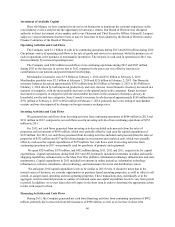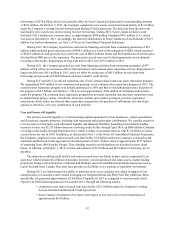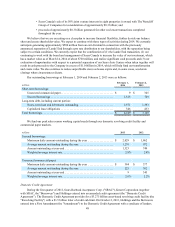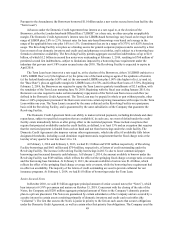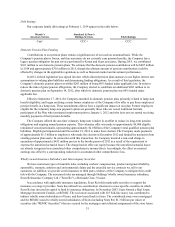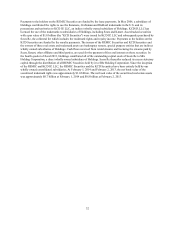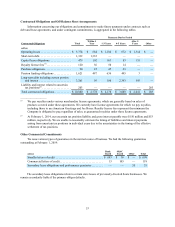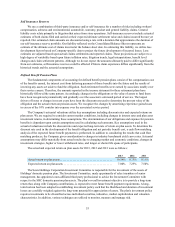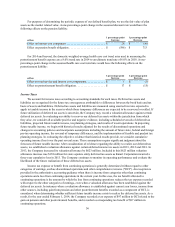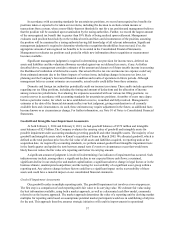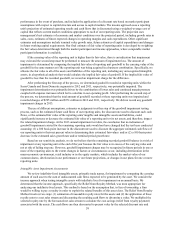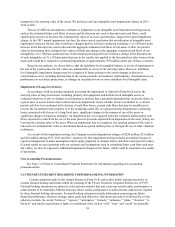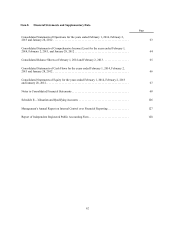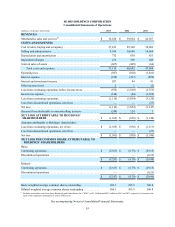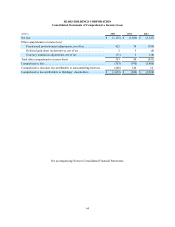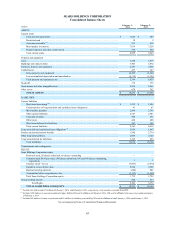Sears 2013 Annual Report Download - page 56
Download and view the complete annual report
Please find page 56 of the 2013 Sears annual report below. You can navigate through the pages in the report by either clicking on the pages listed below, or by using the keyword search tool below to find specific information within the annual report.
56
For purposes of determining the periodic expense of our defined benefit plan, we use the fair value of plan
assets as the market related value. A one-percentage-point change in the assumed discount rate would have the
following effects on the pension liability:
millions 1 percentage-point
Increase 1 percentage-point
Decrease
Effect on interest cost component . . . . . . . . . . . . . . . . . . . . . . . . . . . $ 28 $ (36)
Effect on pension benefit obligation . . . . . . . . . . . . . . . . . . . . . . . . . $ (596) $ 713
For 2014 and beyond, the domestic weighted-average health care cost trend rates used in measuring the
postretirement benefit expense are a 8.0% trend rate in 2014 to an ultimate trend rate of 6.0% in 2018. A one-
percentage-point change in the assumed health care cost trend rate would have the following effects on the
postretirement liability:
millions 1 percentage-point
Increase 1 percentage-point
Decrease
Effect on total service and interest cost components. . . . . . . . . . . . . $ 1 $ (1)
Effect on postretirement benefit obligation . . . . . . . . . . . . . . . . . . . . $ 17 $ (15)
Income Taxes
We account for income taxes according to accounting standards for such taxes. Deferred tax assets and
liabilities are recognized for the future tax consequences attributable to differences between the book basis and tax
basis of assets and liabilities. Deferred tax assets and liabilities are measured using enacted tax rates expected to
apply to taxable income in the years in which those temporary differences are expected to be recovered or settled. If
future utilization of deferred tax assets is uncertain, the Company may record a valuation allowance against certain
deferred tax assets. In evaluating our ability to recover our deferred tax assets within the jurisdiction from which
they arise, we consider all available positive and negative evidence, including scheduled reversals of deferred tax
liabilities, projected future taxable income, tax planning strategies, and results of recent operations. In projecting
future taxable income, we begin with historical results adjusted for the results of discontinued operations and
changes in accounting policies and incorporate assumptions including the amount of future state, federal and foreign
pre-tax operating income, the reversal of temporary differences, and the implementation of feasible and prudent tax
planning strategies. In evaluating the objective evidence that historical results provide, we consider cumulative
operating income (loss) over the past several years. These assumptions require significant judgment about the
forecasts of future taxable income. After consideration of evidence regarding the ability to realize our deferred tax
assets, we established a valuation allowance against certain deferred income tax assets in 2013, 2012 and 2011. In
2013, the Company increased its valuation allowance by $623 million. Included in this $623 million valuation
allowance increase was $138 million for state separate entity deferred tax assets as Kmart Corporation incurred a
three-year cumulative loss in 2013. The Company continues to monitor its operating performance and evaluate the
likelihood of the future realization of these deferred tax assets.
Income tax expense or benefit from continuing operations is generally determined without regard to other
categories of earnings, such as discontinued operations and other comprehensive income ("OCI"). An exception is
provided in the authoritative accounting guidance when there is income from categories other than continuing
operations and a loss from continuing operations in the current year. In this case, the tax benefit allocated to
continuing operations is the amount by which the loss from continuing operations reduces the tax expense recorded
with respect to the other categories of earnings, even when a valuation allowance has been established against the
deferred tax assets. In instances where a valuation allowance is established against current year losses, income from
other sources, including gain from pension and other postretirement benefits recorded as a component of OCI, is
considered when determining whether sufficient future taxable income exists to realize the deferred tax assets. As a
result, for the year ended February 1, 2014, the Company recorded a tax expense of $97 million in OCI related to the
gain on pension and other postretirement benefits, and recorded a corresponding tax benefit of $97 million in
continuing operations.


